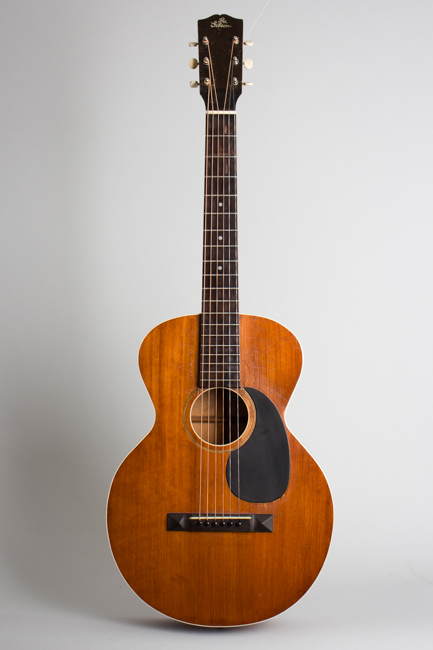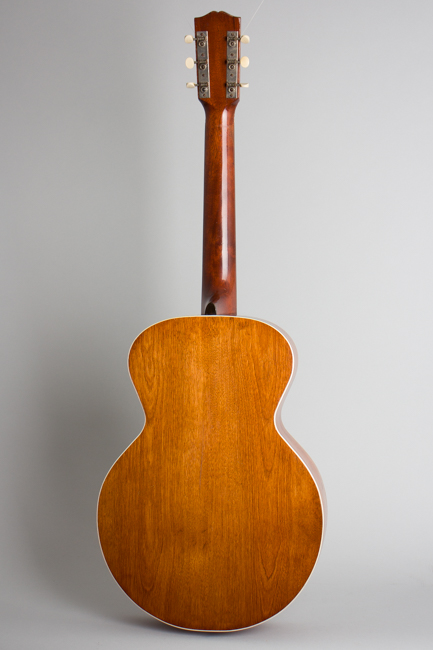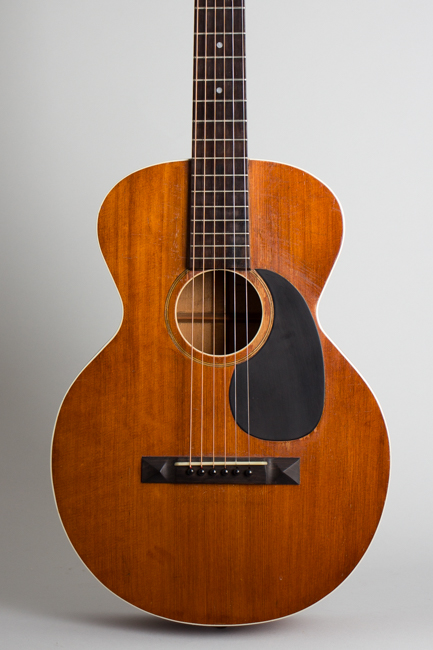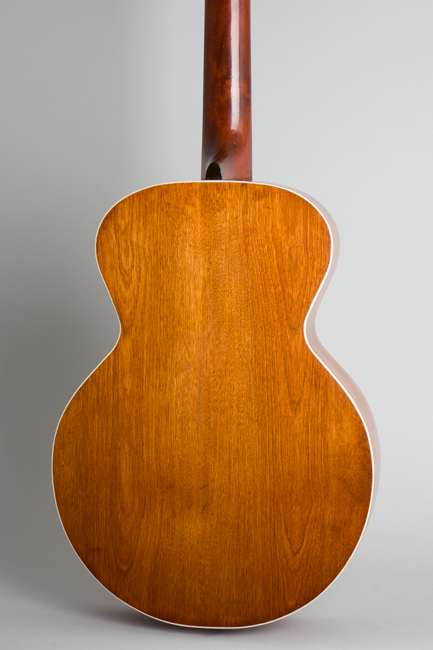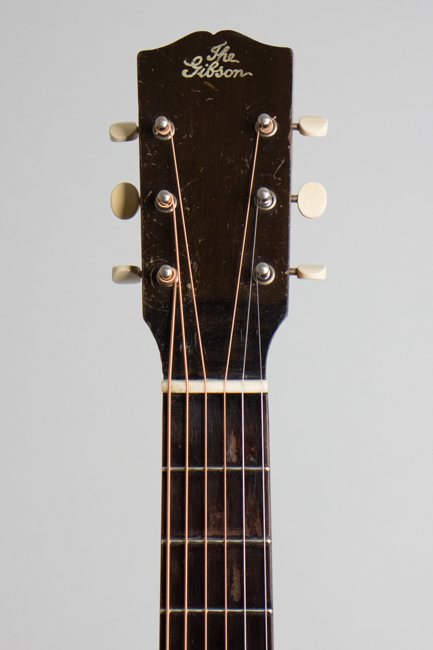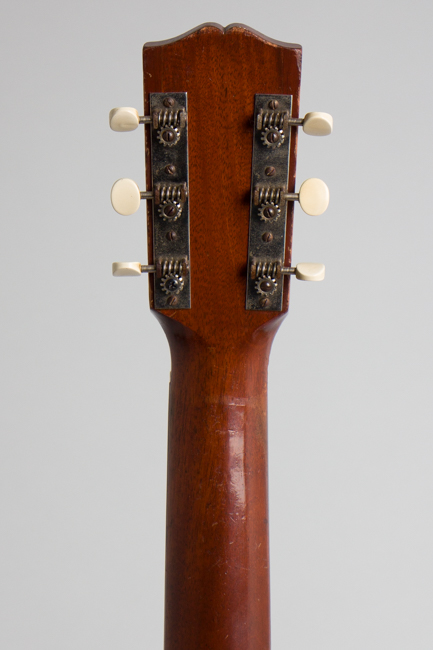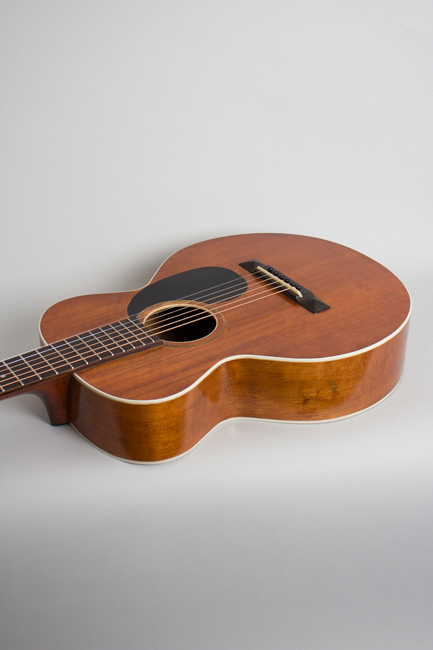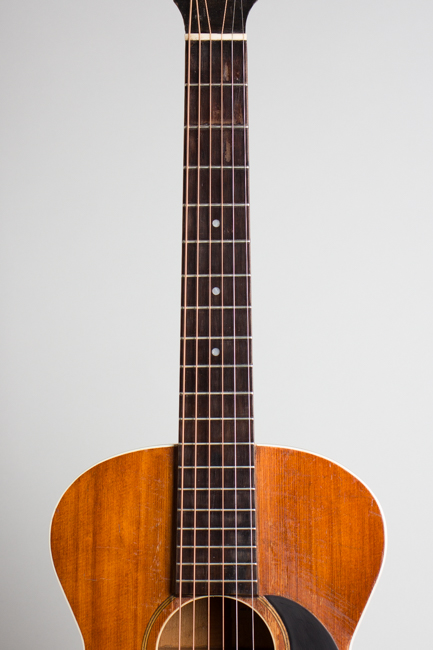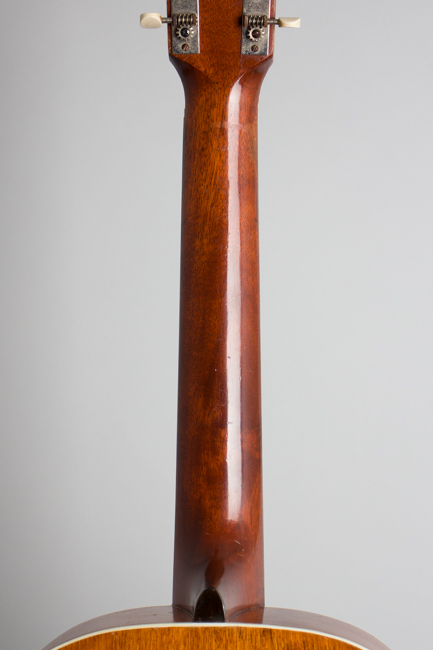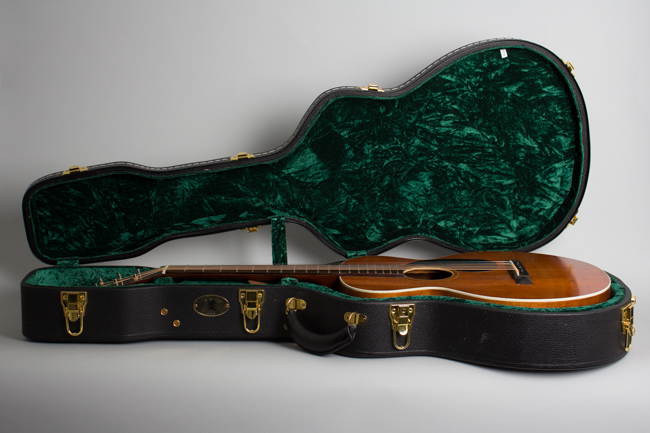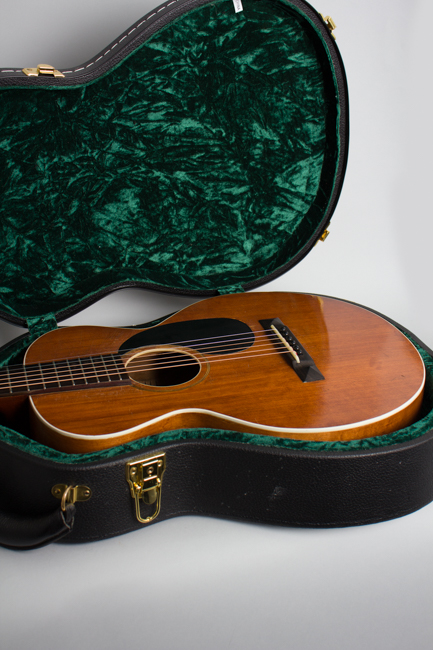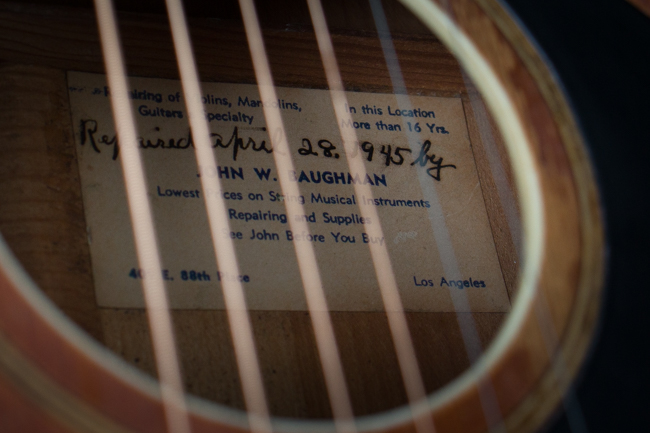Gibson L-0 Flat Top Acoustic Guitar (1926)
Item # 11245
Prices subject to change without notice.
Gibson L-0 Model Flat Top Acoustic Guitar (1926), made in Kalamazoo, Michigan, serial # 8407, brown stain lacquer finish, birch back and sides, spruce top, mahogany neck with dyed maple fingerboard, black tolex hard shell case.
This is a very early example of one of Gibson's first flat-top guitars, the original style L-0. While Gibson's early catalogs vehemently denigrated flat top guitars, by the mid-1920s it became obvious to the company management there was a big market for them that their expensive archtops could not fill. Hawaiian entertainers and the earliest "Hillbilly" entertainers were ready customers and Gibson's flat top line was a success from the start. This guitar is the first-generation L-0, with a Factory Order Number indicating construction in mid-1926, the initial year tit was offered.
These Gibson early flat tops were offered in two models, the $50 L-1 and the $35 L-0, built to the same basic design. Both used the rounded, narrow-waisted body form of the earlier L-1 archtop; some of the first actually used up carved backs held in stock for those never-to-be-made guitars. This one has a standard flat back. The top is braced in an unusual "H" pattern specific to the earliest non-arched Gibsons, only used for a couple of years. The back and sides of the L-0 were cataloged as maple but in this case appear to be birch, a common situation in Gibson's early years.
This L-0 is finished overall in what Gibson called "Amber Brown", with single binding on the top and back. The soundhole has a 5-ply wood ring and a bound edge. The pickguard seen here was added, these did not have one originally. The fairly short 24 1/4" scale neck is a comfortable if wide round-backed affair quite unlike the heavy "V" style used in the '30s. It joins the body at the 12th fret and is not equipped with an adjustable truss rod. The unbound ebonized maple fingerboard has dot inlay at 5th, 7th and 9th frets. "The Gibson" is screened in thin silver script on the headstock, which is fitted with plain openback strip tuners.
All the early small-body Gibson flattops are broadly categorized as "Robert Johnson" guitars, due to the instrument he was photographed with in the 1930's being a very a battered example of this style. This is obviously not that guitar but is certainly still blues approved, a fine player with a punchy, barky sound all its own!
Overall length is 37 3/4 in. (95.9 cm.), 13 7/8 in. (35.2 cm.) wide at lower bout, and 4 in. (10.2 cm.) in depth at side, taken at the end block. Scale length is 24 1/4 in. (616 mm.). Width of nut is 1 7/8 in. (48 mm.).
This guitar has seen a decent amount of repair work both old and new but remains a fine playing and sounding instrument, albeit with its own distinctive flavor. The "amber" finish remains original with some very minor touch up here and there. There are dings, dents and scratches overall (heaviest around the added pickguard) but no large areas of heavy wear. The one obvious alteration is the added pickguard in the Martin style. The bridge is a modern piece with pyramid ends, similar to the original Gibson used around this time but not an exact repro.
The neck has been reset with a wedge added under the fingerboard over the body. The board itself has been trued and refretted, with some light divots remaining in in the first position. As noted the bridge is a semi-repro of the original style. The Martin-style is functional if not visually correct; it could be removed if desired but the top is likely down to bare wood underneath it. There is one small cleated crack in the center of the back, but no other cracks. The tuners appear the correct original style although they have smooth shafts not standard for Gibson at this time. Internally the guitar is unaltered including the thin but long Stella-style bridge plate. The top is in excellent shape with none of the common bulge distortion, one of the best of these we have seen.
There is an interesting old business care glued on the inside back indicating the guitar was repaired in April 1945 by John W. Baughmann in Los Angeles; we cannot say for sure what repairs he performed but it does add a bit of history to the guitar. Except for the visual incongruity of the added pickguard this is a great looking and fine playing example of this primal Gibson flat top, structurally excellent and a very good playing and sounding guitar. The tone is not as sweet as many other flat-top Gibsons, but punchy and surprisingly powerful, equally suitable for Johnson-esque blues or many other styles vintage and modern. Very Good + Condition.
This is a very early example of one of Gibson's first flat-top guitars, the original style L-0. While Gibson's early catalogs vehemently denigrated flat top guitars, by the mid-1920s it became obvious to the company management there was a big market for them that their expensive archtops could not fill. Hawaiian entertainers and the earliest "Hillbilly" entertainers were ready customers and Gibson's flat top line was a success from the start. This guitar is the first-generation L-0, with a Factory Order Number indicating construction in mid-1926, the initial year tit was offered.
These Gibson early flat tops were offered in two models, the $50 L-1 and the $35 L-0, built to the same basic design. Both used the rounded, narrow-waisted body form of the earlier L-1 archtop; some of the first actually used up carved backs held in stock for those never-to-be-made guitars. This one has a standard flat back. The top is braced in an unusual "H" pattern specific to the earliest non-arched Gibsons, only used for a couple of years. The back and sides of the L-0 were cataloged as maple but in this case appear to be birch, a common situation in Gibson's early years.
This L-0 is finished overall in what Gibson called "Amber Brown", with single binding on the top and back. The soundhole has a 5-ply wood ring and a bound edge. The pickguard seen here was added, these did not have one originally. The fairly short 24 1/4" scale neck is a comfortable if wide round-backed affair quite unlike the heavy "V" style used in the '30s. It joins the body at the 12th fret and is not equipped with an adjustable truss rod. The unbound ebonized maple fingerboard has dot inlay at 5th, 7th and 9th frets. "The Gibson" is screened in thin silver script on the headstock, which is fitted with plain openback strip tuners.
All the early small-body Gibson flattops are broadly categorized as "Robert Johnson" guitars, due to the instrument he was photographed with in the 1930's being a very a battered example of this style. This is obviously not that guitar but is certainly still blues approved, a fine player with a punchy, barky sound all its own!
Overall length is 37 3/4 in. (95.9 cm.), 13 7/8 in. (35.2 cm.) wide at lower bout, and 4 in. (10.2 cm.) in depth at side, taken at the end block. Scale length is 24 1/4 in. (616 mm.). Width of nut is 1 7/8 in. (48 mm.).
This guitar has seen a decent amount of repair work both old and new but remains a fine playing and sounding instrument, albeit with its own distinctive flavor. The "amber" finish remains original with some very minor touch up here and there. There are dings, dents and scratches overall (heaviest around the added pickguard) but no large areas of heavy wear. The one obvious alteration is the added pickguard in the Martin style. The bridge is a modern piece with pyramid ends, similar to the original Gibson used around this time but not an exact repro.
The neck has been reset with a wedge added under the fingerboard over the body. The board itself has been trued and refretted, with some light divots remaining in in the first position. As noted the bridge is a semi-repro of the original style. The Martin-style is functional if not visually correct; it could be removed if desired but the top is likely down to bare wood underneath it. There is one small cleated crack in the center of the back, but no other cracks. The tuners appear the correct original style although they have smooth shafts not standard for Gibson at this time. Internally the guitar is unaltered including the thin but long Stella-style bridge plate. The top is in excellent shape with none of the common bulge distortion, one of the best of these we have seen.
There is an interesting old business care glued on the inside back indicating the guitar was repaired in April 1945 by John W. Baughmann in Los Angeles; we cannot say for sure what repairs he performed but it does add a bit of history to the guitar. Except for the visual incongruity of the added pickguard this is a great looking and fine playing example of this primal Gibson flat top, structurally excellent and a very good playing and sounding guitar. The tone is not as sweet as many other flat-top Gibsons, but punchy and surprisingly powerful, equally suitable for Johnson-esque blues or many other styles vintage and modern. Very Good + Condition.
